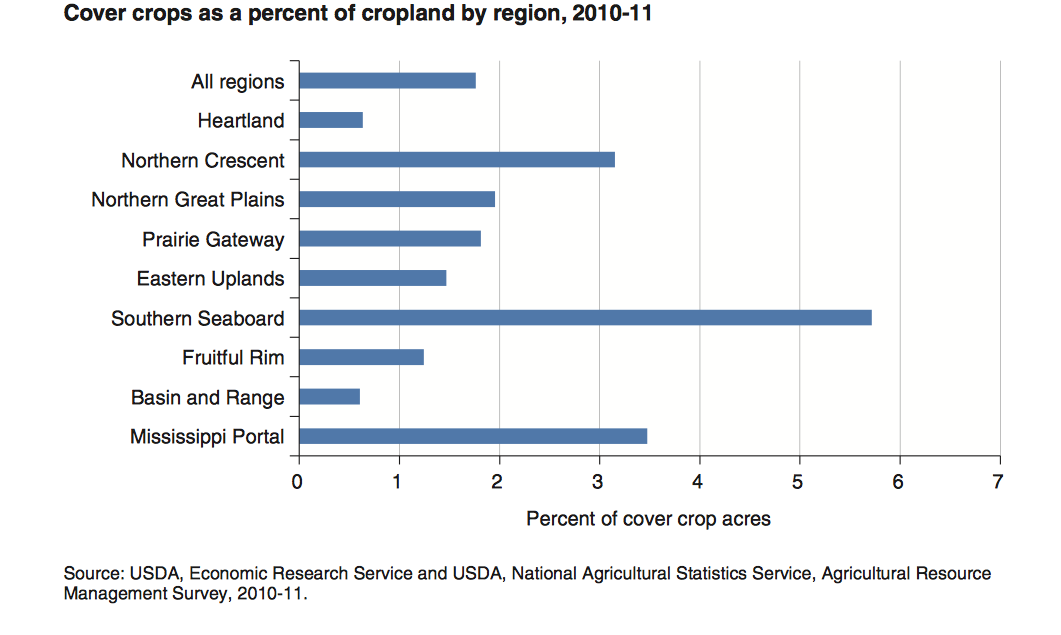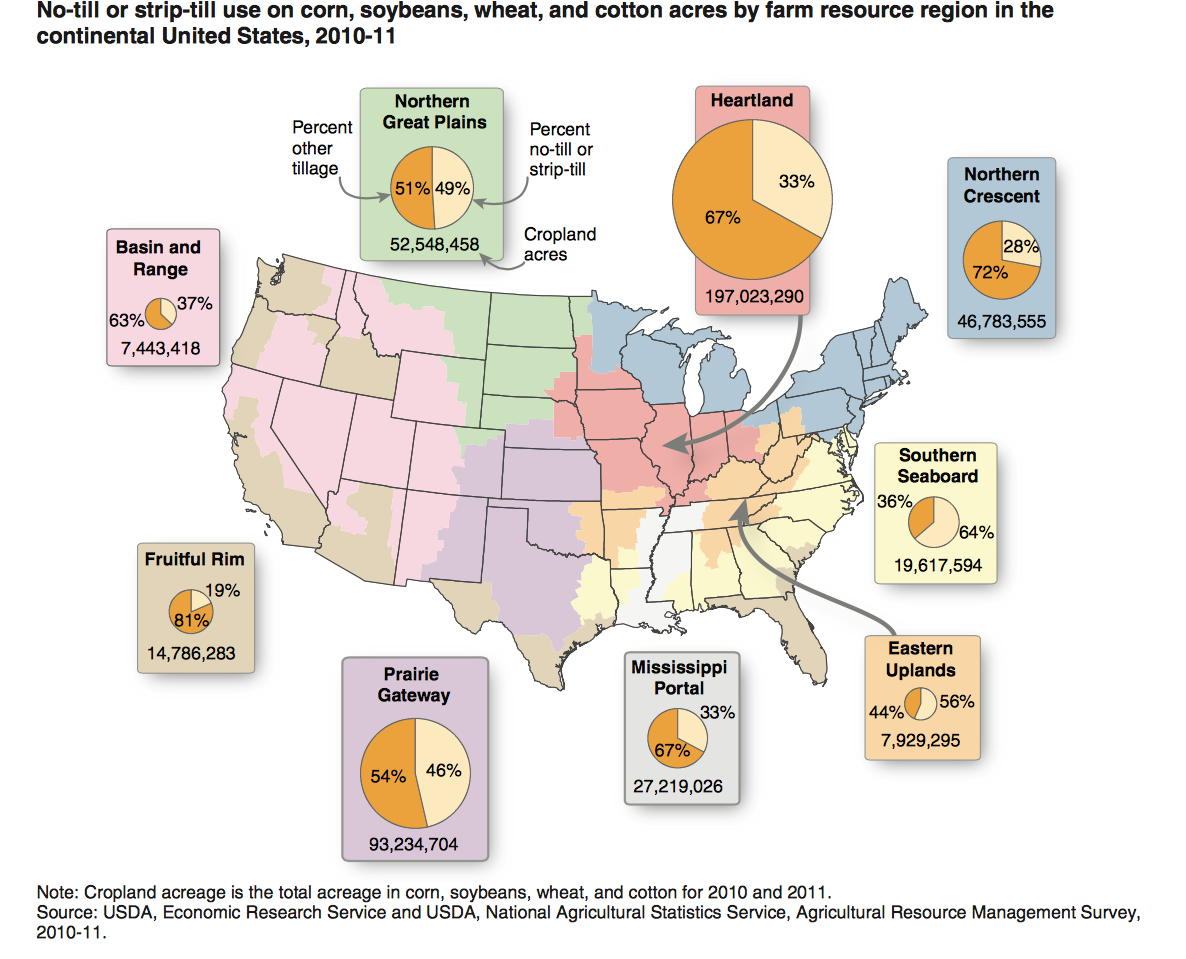The U.S. Department of Agriculture (USDA)’s Economic Research Service (ERS) recently released a report on conservation practice adoption, highlighting the fairly low adoption rates for specific practices that play a critical role in mitigating environmental impacts, improving soil health, and reducing greenhouse gas emissions.
The report, “Conservation-Practice Adoption Rates Vary Widely by Crop and Region” used data from the Agricultural Resource Management Survey (ARMS) to highlight no-till/strip till, cover crop, and nutrient management practices.
The report examined data for land planted to corn, soybean, wheat, and cotton, which accounted for roughly 80 percent of all principal crop acreage in 2010 and 2011. Principal crop acreage includes acres planted to all major crops, including those eventually cut for hay. Corn, soy, wheat and cotton accounted for 225 million acres in 2010 and 242 million acres in 2011.
Conservation Practices Provide Significant Benefits
The study focused on conservation tillage practices, cover crop adoption, and nutrient management because of the significant environmental benefits off the farm, as well as the on-farm benefits to soil health and nutrient availability, which increase agricultural productivity.
- Tillage Practices – In a no-till system, farmers limit soil disturbance completely by planting directly into the residue of the previous crop. Farmers who adopt strip-tillage only till a narrow strip where row-crops are planted, leaving the rest of the soil undisturbed. No-till and strip-till production reduces soil erosion and sediment loss to water and wind, which mitigates sediment movement into bodies of water. Reduced tillage systems also increase soil carbon sequestration, water holding capacity, and soil organic matter content, while limiting soil compaction.
- Cover Crops – Cover crops play a critical role in improving soil health, as they keep the soil covered when an economic crop is not growing. They reduce soil erosion, prevent nutrient loss, increase biomass, reduce weeds, loosen the soil to reduce compaction, and improve water infiltration to capture and store spring rainfall. These benefits are gained more quickly when adopted with no-till or strip till-systems. The cover crop data included in the report are relative to all planted acres, as opposed to only corn, soybeans, cotton, and wheat, because ARMS data does not link cover crops to specific harvested crops.
- Nutrient Management – Finally, nutrient management reduces the loss of fertilizer or manure nitrogen to water or air. Management provides critical water benefits, because nitrate (the nitrogen form used by plants) is water soluble and can be easily lost, causing water quality problems hundreds of miles from the source. Nitrogen can also be lost to the atmosphere in the form of nitrous oxide, which is a powerful greenhouse gas. Nitrogen management involved applying nitrogen fertilizer and manure in amounts that match the crop and field conditions, at a time that corresponds with nutrient needs, and reducing runoff. Major nitrogen management criteria include the following: no fall application of nitrogen, at least some post-plant application of nitrogen, nitrogen application rates no larger than the benchmark rate, and incorporating nitrogen below the soil surface.
What the Study Found
The ERS study found that conservation practices vary widely across regions and by crops. Major findings of the study include the following:
- Approximately 40 percent of corn, soy, wheat, and cotton were in no-till or strip-till in 2010 and 2011, covering 89 million acres per year. Adoption rates were highest for soybeans, as well as in the Southern Seaboard region. Some farms used no-till/ strip-till on all land in these crops, while others used a mix of tillage practices on their land in production. The map below illustrates tillage rates by region.
- Cover crops were used on less than 2 percent of total cropland (for all crops), covering 6.8 million acres. Cover crop adoption was higher in some regions, including the Southern Seaboard and the Mississippi Portal. The chart below illustrates cover crop adoption rates by region for 2010-11.
 (Note that cover crop adoption has likely increased since 2011. See Cover Crop Survey Confirms Benefits and 2012 Census of Agriculture Conservation Results.)
(Note that cover crop adoption has likely increased since 2011. See Cover Crop Survey Confirms Benefits and 2012 Census of Agriculture Conservation Results.)
- The percentage of farmers who reported nitrogen application rates higher than benchmark application rates (based on the estimated plant uptake, designed to minimize losses to the environment) varied by crop – 36 percent of corn acres, 19 percent of cotton acres, 22 percent of spring wheat acres, and 25 percent of winter wheat acres.
USDA Conservation Programs Support Critical Practices
As the study points out, farm bill conservation programs provide support that may encourage adoption of best management practices, and even provide a demonstration effect that encourages other farmers to also adopt these practices.
The Environmental Quality Incentives Program (EQIP) provides financial cost-share assistance and technical assistance for producers to implement conservation practices on working agricultural land, while the Conservation Stewardship Program (CSP) provides farmers and ranchers technical and financial assistance to actively manage existing conservation and to implement additional conservation activities throughout their whole farm.
No-till and strip-till adoption, planting of cover crops, and nutrient managements are all practices supported by EQIP and CSP, the farm bill’s two large working lands conservation programs.
- Through EQIP, producers can receive support to cover the cost of transitioning to no-till or strip-till, plant cover crops, write nutrient management plans, and implement key nutrient management strategies that slow runoff, reduce erosion, increase infiltration, and reduce the loss of nitrates or soluble phosphorus.
- CSP offers also enhancements (advanced conservation activities) that similarly support these key conservation benefits — participants can select enhancements that include cover crops for weed suppression and soil health, intensive cover cropping in annual crops, the use of cover crop mixes, intensive no-till, and nutrient management strategies such as reduced concentration of nutrients imported to the farm and on farm composting farm organic waste.
- CSP provides additional opportunities for producers to reduce inputs, such as transitioning to organic crop production.
Conservation Practices Bring Climate Benefits, Too
In addition to soil and water quality benefits, the highlighted conservation practices also offer significant climate benefits and are critical in meeting climate change adaptation goals under the USDA Climate Change Action Plan.
In this final year of the Administration, USDA should take advantage of clear opportunities to address climate change, and as the report points out, retaining residue, adopting cover crops, and nutrient management offer unique benefits that support climate change adaptation and mitigation.
Seven of the 10 Ways USDA Can Address Climate Change in 2016 deal with federal conservation programs. In light of the relatively low adoption rates of many of the key conservation activities revealed in this ERS report, these recommendations for 2016 are clearly relevant and timely.
A summary of the ERS report and the full publication are available for download online.



Low adoption of programs is mainly due to the hoops and hassle USDA puts you through. For example: I applied for programs and got a bonus because of my status as a ‘Beginning Farmer’. You would think that USDA would require proof or validate one’s qualification as a ‘Beginning Farmer’ before they enroll you in programs. Well apparently not because I just got asked to “prove” my qualification as a ‘Beginning farmer’ by providing copies of tax returns from 2008 or before. Well, I don’t keep tax forms for that long. IRS only keeps copies from 3 years ago. So now what’s going to happen? Will I have to return the money? Don’t know yet.
Question: Why would USDA approve someone for a program with out verifying that they are qualified first?
That is just one example. If you take a survey I’m sure you will find that farmers just don’t want the hassle of dealing with bureaucrats.